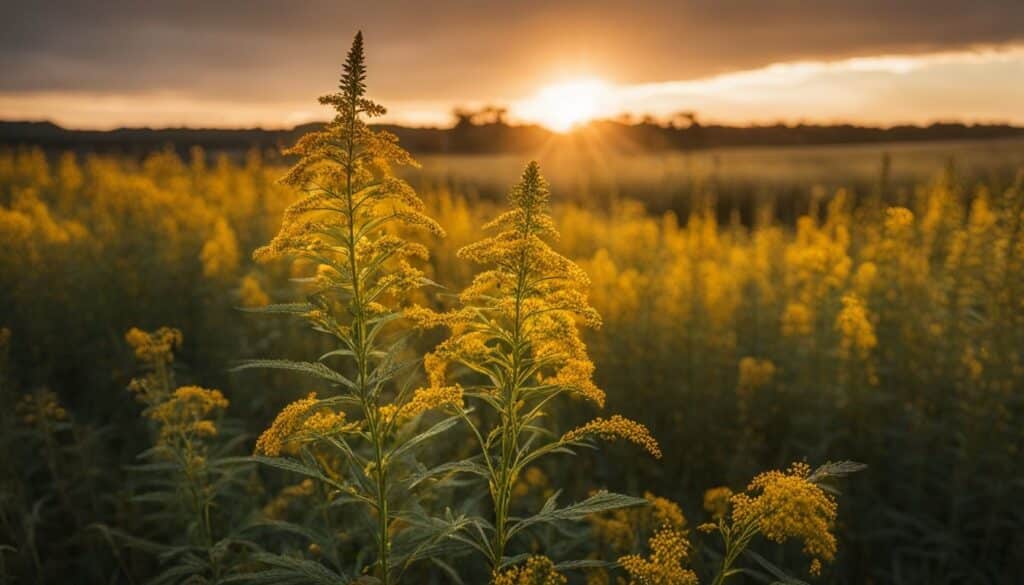Goldenrod Allergies: Myths And Facts

Many people think about goldenrod allergy, but often, it’s not true. Goldenrod has heavy pollen that bugs love, which means it doesn’t fly around in the air to make you sneeze.
The real problem is a different plant called ragweed. It has light pollen that the wind carries to your nose and can give you hay fever. Often, folks mix up goldenrod and ragweed and remove the helpful goldenrod from their gardens.
Goldenrods are great for nature. They have bright flowers that bring good insects to them and can even help with health problems like stuffy noses or bathroom troubles. Plus, they’re good for many different living things to grow together.
It’s important to know what each plant looks like so we don’t blame the wrong one for our sniffles! Let’s learn about these plants so we can enjoy goldenrods without worry. Keep reading to discover how these plants differ and why we should welcome goldenrods into our gardens!
Key Takeaways
- Goldenrod pollen is heavy and sticky; it doesn’t travel far, so it’s not likely to cause allergies. Ragweed pollen is light and can float for miles, causing most fall allergy symptoms.
- Goldenrod plants have bright yellow flowers that attract bees and butterflies, which help carry their pollen. Because of this, they support biodiversity and help other plants grow.
- Ragweed has green flowers that are hard to see. It grows in many places across North America during late summer when goldenrod also blooms.
- Some people use goldenrod for its medicinal properties. It has been used to treat things like colds and kidney stones for a long time.
- To tell the difference between goldenrod and ragweed, look at the plant’s leaves, flower color, height, where it grows, and if bees like it.
Allergy Myths: The Truth About Goldenrod
Despite popular belief, goldenrod is often mistaken for causing allergies when the ragweed gets the blame. Understanding the differences between these plants and their pollen can illuminate the true culprit of allergy symptoms.
Mistaken identity with ragweed

Goldenrod often gets blamed for sneezes and itchy eyes. But the real troublemaker is ragweed. These two plants are different, yet they bloom simultaneously in late summer. Ragweed releases billions of pollen grains that fly through the air and cause hay fever.
Goldenrod pollen is heavy and sticky, so it doesn’t travel far from the flower. This means goldenrod isn’t likely to make you sneeze or get itchy eyes.
Many people see goldenrods’ bright yellow flowers and think they’re causing their allergy symptoms. In truth, ragweed has green flowers that don’t catch your eye as much. Since these plants are close relatives, if you’re allergic to one, you might react to the other too.
Still, remember that most of the sniffles come from ragweed pollen in the air, not goldenrod by your home.
Different types of pollen and plant reproduction
Plants use pollen to make seeds and create new plants. This powder is very tiny, and each plant makes its kind. Some plants, like goldenrod, have heavy pollen that insects carry from flower to flower.
These flowers are bright and full of nectar, which attracts bees, butterflies, and other pollinators.
Other plants rely on the wind to move their light pollen around. Ragweed is one of these plants whose small grains can float far in the air. Many people with allergies react to ragweed‘s lightweight pollen because it easily gets into noses and throats, causing sneezes and sniffles.
Environmental factors of allergies
Many things in the environment can cause allergies. Pollen is a big one that makes many people sneeze and get itchy eyes, especially during certain times of the year. But not all plants are bad for allergies.
Some plants, like goldenrod, have heavy pollen that bees move from flower to flower. The wind doesn’t carry this kind of pollen far, so it’s less likely to make you sniffle and sneeze.
Also, living close to roads or fields where lots of ragweed grows can be tough for allergy sufferers. Ragweed releases tiny bits of pollen into the air that can travel miles on the wind! This plant blooms simultaneously as goldenrod, so sometimes people think goldenrod makes them feel sick when it’s ragweed causing all those pesky allergy symptoms.
The Benefits of Goldenrod
Goldenrod has many benefits beyond its perceived allergic properties. It attracts beneficial insects and pollinators, contributes to biodiversity, and possesses medicinal properties that have been used for centuries.
These factors make goldenrod a valuable plant in various ecosystems and for human health.
Attracts beneficial insects and pollinators
Goldenrod is a pretty flower and essential in supporting beneficial insects and pollinators. Its bright, colorful blooms are like a beacon for bees, butterflies, and other important pollinating insects.
These insects rely on goldenrod as a source of nectar and pollen, helping them thrive. The presence of goldenrods can significantly promote ecosystem biodiversity by providing food and habitat for these vital insect populations.
The attraction of beneficial insects also enhances the environment’s overall health. Bees and other pollinators play a crucial role in the reproduction of various plant species, including many that are important for human consumption.
Medicinal properties
Goldenrod is a perennial flowering plant with bright yellow blooms that has been used for its medicinal properties for centuries. It contains beneficial compounds like saponins and flavonoid antioxidants, which have anti-inflammatory and antimicrobial effects.
The flower and leaf of goldenrod offer medicinal benefits such as treating allergies, sinus infections, colds, urinary tract infections, kidney stones, and even hemorrhoids. German folk medicine extensively uses goldenrod for treating urinary retention issues.
Its widespread use in traditional medicine highlights its effectiveness in various health conditions.
Promotes biodiversity
Goldenrod plays a crucial role in promoting biodiversity. These top-ranked herbaceous plants offer late-season nectar and pollen to pollinators, supporting the ecosystem’s health. Their insect-pollinated nature attracts beneficial insects and pollinators like bees, contributing to preserving diverse plant species.
Additionally, as goldenrods attract an array of pollinators with their flowers, they also aid in maintaining a healthy balance within ecosystems by providing essential support to other native flora.
This means that by fostering goldenrod growth, individuals can contribute positively towards preserving the natural diversity of plant life and its associated benefits for human health and well-being.
How to Tell the Difference Between Goldenrod and Ragweed
When differentiating between goldenrod and ragweed, physical differences in appearance and pollen characteristics can be key indicators. Understanding these distinctions is essential for effectively managing allergies during the pollination season.
If you want to learn more about identifying and appreciating goldenrod properly, keep reading!
Physical differences
Goldenrod and ragweed have distinct physical characteristics that help in their identification. Here are the key differences:
- Leaf Shape: Goldenrod leaves are typically serrated or deeply veined, whereas ragweed leaves are scalloped or rounded.
- Flower Appearance: Goldenrods have bright, showy flower heads, while ragweed’s flowers are small and inconspicuous, lacking vibrant colors.
- Plant Structure: Goldenrods usually grow as single woody stems reaching heights of 3 feet or more, while ragweed may have several branches with a bushy appearance.
- Growth Habits: Goldenrods are often found along roadsides and open fields, whereas ragweed is native to North America and commonly grows in disturbed areas.
- Allergenic Properties: It’s important to note that despite visual similarities, goldenrod is not responsible for causing hay fever as commonly believed; it is the pollen from ragweed plants that triggers allergic reactions during late summer and early fall.
Pollen and allergy information

Regarding pollen and allergies, it’s important to distinguish between goldenrod and ragweed. Ragweed is the real culprit for fall allergies as it produces hazardous allergen pollen, while goldenrod’s large and sticky pollen is unlikely to cause allergic reactions.
Goldenrod should not get blamed for annoying allergy symptoms, especially since its pollination method relies on insects rather than wind dispersal like ragweed. Goldenrod plants provide essential benefits such as attracting pollinating insects and promoting biodiversity while offering medicinal properties used in traditional treatments.
Goldenrod does produce some amount of airborne pollen like any other flowering plant. Still, its pollen grains are less likely to trigger allergic rhinitis or asthma than smaller ragweed pollen grains, which often get blamed during allergy season.
How to Properly Identify and Appreciate Goldenrod
Goldenrod can be properly identified and appreciated by following these steps:
- Look for clusters of small, yellow flowers with a distinctive shape at the top of single woody stems.
- Notice the absence of ragweed-like green flowers and the lack of the notorious ragweed scent.
- Observe how goldenrod attracts beneficial insects such as bees and butterflies, promoting a healthy ecosystem.
- Appreciate its traditional medicinal uses, including treating kidney stones and urinary issues.
- Understand that goldenrod’s pollen is heavy and not easily dispersed by the wind, decreasing its likelihood of causing allergies.
FAQs
1. Can goldenrod plants cause allergies?
No, goldenrod is often blamed for allergies, but the ragweed causes most problems. Goldenrod pollen sticks to insects and doesn’t fly in the wind much.
2. When do people usually get ragweed allergies?
Ragweed allergies mostly happen in August and September when ragweed flowers release pollen.
3. How can I tell if I’m allergic to goldenrod or ragweed?
If you have a runny nose, itching mouth, or throat during late summer, it might be a ragweed allergy because goldenrod doesn’t spread much pollen in the air.
4. Are there many types of goldenrods?
Yes! At least 130 different species of goldenrod plants are found all over places like the United States and Canada.
5. Do all flowers spread their pollen by wind?
No, not all do! Unlike ambrosia species like ragweed that send billions of tiny grains through wind to disperse them in wide areas, some plants rely on bugs to carry their heavy pollen from one flower to another.
6. Is there any good use for goldenrods besides looking pretty?
Sure! Some people used Goldenrods long ago to help with things like healing cuts and even treating kidney stones because they believed these sturdy wildflowers had special powers.

